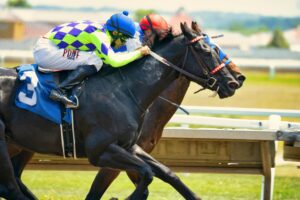 In the early years of the twenty-first century, it would be fair to say that something of a ‘hoodoo’ existed for Grand National winners, in terms of ever winning another race. In fact, after Bindaree, who won at Aintree in April 2002 and eventually followed up, ten starts later, in the Welsh National at Chepstow in December 2003, the next Grand National-winning horse to win again was Pineau De Re. A 5-length winner at Aintree in April 2014, as an 11-year-old, the Dr. Richard Newland-trained gelding popped up again, in a Pertemps Series Qualifier over hurdles at Carlisle in December 2015, before failing to complete the course on three of his last four starts.
In the early years of the twenty-first century, it would be fair to say that something of a ‘hoodoo’ existed for Grand National winners, in terms of ever winning another race. In fact, after Bindaree, who won at Aintree in April 2002 and eventually followed up, ten starts later, in the Welsh National at Chepstow in December 2003, the next Grand National-winning horse to win again was Pineau De Re. A 5-length winner at Aintree in April 2014, as an 11-year-old, the Dr. Richard Newland-trained gelding popped up again, in a Pertemps Series Qualifier over hurdles at Carlisle in December 2015, before failing to complete the course on three of his last four starts.
In between Bindaree and Pineau De Re, though, a total of 13 Grand National winners failed to win again, collectively accumulating a total of 102 losing starts. Of course, Pineau De Re did manage to win again, as did the ultimately ill-fated Many Clouds, who shouldered 11st 9lb to victory at Aintree in 2015. In fact, the latter recorded three more wins, including what would have been a famous, rather than infamous, defeat of King George VI Chase winner Thistlecrack in the Cotswold Chase at Cheltenham two years later, but for the fact that he tragically collapsed and died afterwards, having suffered a severe pulmonary haemorrhage.
Next up came Rule The World, trained in Co. Tipperary by Michael ‘Mouse’ Morris, who, in 2016, while still a maiden – albeit a high-class maiden – over regulation fences, belied his ‘novice’ status by winning the race often described as the ‘ultimate test for horse and rider’. A largely unconsidered 33/1 chance at Aintree, the 9-year-old survived a blunder at the penultimate open ditch, led inside the final half-a-furlong or so, and stayed on well to win by 6 lengths. In so doing, Rule The World became the first novice to win the Grand National since Mr. What in 1958. He raced just once more, finishing down the field in the Champion Novice Chase at Punchestown, less than three weeks later, before retirement.
The 2017 Grand National winner, One For Arthur, saddled by Lucinda Russell – and, therefore, just the second Scottish-trained winner, after Rubstic in 1979 – was another who failed to add to his winning tally. He did, however, finish a creditable, if somewhat remote, sixth behind Tiger Roll on his return to Aintree in 2019.
Ah, Tiger Roll. The winner of the Triumph Hurdle in 2014 and the National Hunt Chase in 2017, the diminutive Authorized gelding warmed up for his first attempt at the Grand National, in 2018, with yet another Cheltenham Festival win, in the Cross Country Chase. All out to win by a head on that occasion, despite holding a 6-length lead at the famous ‘Elbow’, halfway up the run-in, he nonetheless won the National again, off a 9lb higher mark, in 2019, justifying favouritism in the process. Denied the chance of an unprecedented hat-trick (in consecutive years, that is) by the Covid-19 pandemic, Tiger Roll never attempted the National again, but did add to his Festival tally with a facile, 18-length victory in the Cross Country Chase, again, in 2021.
The 2021 National winner, Minella Times, was another to make history, insofar as his jockey, Rachael Blackmore, became the first female jockey to win the Aintree showpiece. Brought down at Valentine’s Brook on the first circuit in the 2022 renewal, the son of high-class jumps sire Oscar was being prepared for another crack at the National in 2023, but suffered a training setback and was retired forthwith, as a 10-year-old, having never won again.
The two most recent National winners, Noble Yeats in 2022 and Corach Rambler in 2023, remain in training. The former has already won three times since and, at the time of writing, is a single-figure price for the Stayers’ Hurdle at the 2024 Cheltenham Festival, while the latter has had just two, unsuccessful, starts since, and remains co-favourite for the 2024 Grand National.

 The Grand National is arguably the most famous horse race in the world and, according to the BBC, attracts a global television audience of approximately 600 million. In the last decade or so, the Jockey Club, which owns Aintree Racecourse, has invested heavily in safety changes but, based on its own research and a number of independent studies, has announced further measures to be implemented before the next running of the Grand National on April 13, 2024.
The Grand National is arguably the most famous horse race in the world and, according to the BBC, attracts a global television audience of approximately 600 million. In the last decade or so, the Jockey Club, which owns Aintree Racecourse, has invested heavily in safety changes but, based on its own research and a number of independent studies, has announced further measures to be implemented before the next running of the Grand National on April 13, 2024. In the early years of the twenty-first century, it would be fair to say that something of a ‘hoodoo’ existed for Grand National winners, in terms of ever winning another race. In fact, after Bindaree, who won at Aintree in April 2002 and eventually followed up, ten starts later, in the Welsh National at Chepstow in December 2003, the next Grand National-winning horse to win again was Pineau De Re. A 5-length winner at Aintree in April 2014, as an 11-year-old, the Dr. Richard Newland-trained gelding popped up again, in a Pertemps Series Qualifier over hurdles at Carlisle in December 2015, before failing to complete the course on three of his last four starts.
In the early years of the twenty-first century, it would be fair to say that something of a ‘hoodoo’ existed for Grand National winners, in terms of ever winning another race. In fact, after Bindaree, who won at Aintree in April 2002 and eventually followed up, ten starts later, in the Welsh National at Chepstow in December 2003, the next Grand National-winning horse to win again was Pineau De Re. A 5-length winner at Aintree in April 2014, as an 11-year-old, the Dr. Richard Newland-trained gelding popped up again, in a Pertemps Series Qualifier over hurdles at Carlisle in December 2015, before failing to complete the course on three of his last four starts.